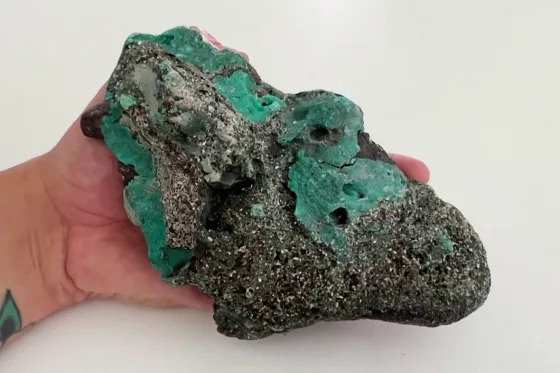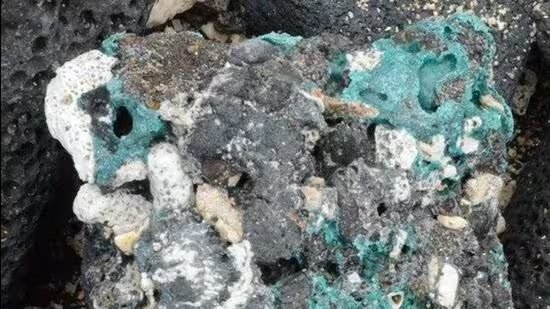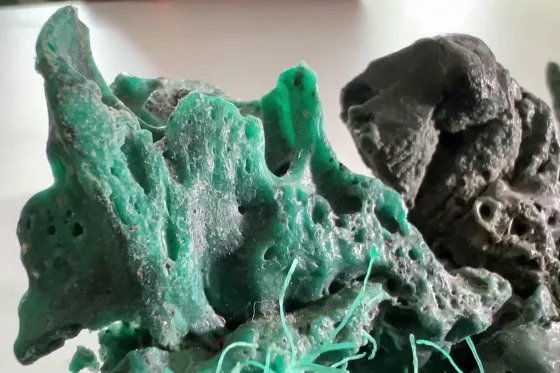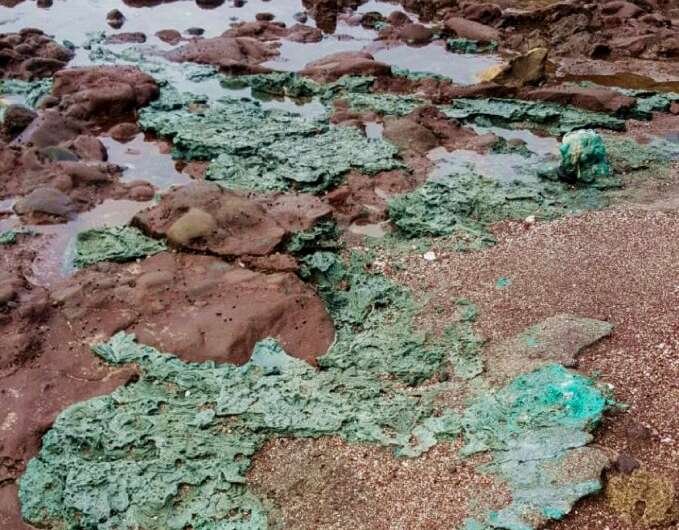Introduction:
In an era marked by profound environmental changes, one of the most striking signatures of human impact on the planet is the emergence of ‘plastic rocks’. These novel geological formations, a direct result of the pervasive spread of plastic pollution, symbolize the intersection of natural processes and human activity.
Plastic rocks are essentially stones that have formed through the incorporation of various types of plastics into natural materials, usually found in coastal and marine environments.

As the world grapples with the challenges of plastic pollution, the phenomenon of plastic rocks offers a tangible, yet disturbing, representation of the deep and potentially irreversible changes humans are imprinting on the natural world. Thus the study about the these rocks becomes a topic that encapsulates one of the most pressing environmental issues of our time.
What Are Plastic Rocks?
The phenomenon of plastic rocks is not just a testament to the resilience and adaptability of nature in the face of human-induced changes but also a sobering reminder of the enduring legacy of our consumption patterns. These rocks often consist of a mix of natural sedimentary materials like sand, volcanic rock, and organic debris, fused with a range of plastic products – from bottle caps and cigarette lighters to larger plastic fragments.
The formation of these rocks typically occurs in environments where heat, either from sunlight, fires, or geological processes, melds these materials together.
These have different terminologies suggesting their ways of formation; like – plastistone, plastiglomerate, plasticrust, plastitar, plastisandstone, anthropoquinas etc. These different terms describe how these rocks develop in specific ways.
First Ever Sample of Plastic Rocks:
The first-ever sample of plastic rocks was identified in Hawaii by the geologist Patricia Corcoran. She coined the terminology ‘plastiglomerate’ as its formation process is to some extent similar to conglomerate formation.
Deyi Hou, an associate professor at Tsinghua University specializing in environmental studies, and his team have recently pioneered research into the plastic rock phenomenon. Hou’s team conducted a comprehensive review, confirming the presence of these unique formations across 5 continents and in 11 different countries, highlighting the global extent of this environmental issue. This research has been pivotal in shedding light on the complex chemical bonds that form between plastic materials and rocks.
Where Are Plastic Rocks Found Now?
Latest reports have indicated that rocks have been found not only in Hawaii, but also in Brazil, Bangladesh, China, Japan, India, Italy, Portugal, Peru, the United Kingdom, and Spanish Curry Island. These reports are clear pieces of evidence of the widespread nature of plastic as well as the environmental pollution crisis.
How Are Plastic Rocks Formed?
Hou’s team has elaborated on the various processes through which plastic rocks are formed.
Plastic Burning: According to Hou, burning is a prevalent method where plastic waste melts during activities like campfires or waste incineration. This molten plastic then integrates into the surrounding mineral structures as it cools, resulting in the formation of plastic rocks.
Wave Action: Additionally, Hou noted that in coastal regions, the action of waves crashing against the rocks can cause plastic debris from marine sources to become physically attached to the rock surfaces, contributing to this phenomenon.
Oil Spill: Hou and his research team have identified another formation process for the rocks. This occurs when oil containing a substantial amount of plastic, often due to a leak, reaches a beach. The plastic-enriched oil firmly attaches to the existing rock matrix, and then undergoes a process of partial evaporation and solidification, as explained by Hou.
Chemical Bonding between Plastics and Rocks: Moreover, Hou mentioned a unique finding in their study regarding the formation of plastic rocks in inland areas. They observed that the action of sunlight irradiation could lead to the oxidation of plastic, resulting in a chemical bond between the plastic and the rock materials. This process contributes significantly to the creation of ‘plasticine’ in non-coastal regions, further expanding the understanding of how these unique geological formations develop in various environments
Why Are Plastic Rocks Complicated Situation?
Gabriel Enrique De-la-Torre, a researcher specializing in plastic pollution at Universidad San Ignacio de Loyola in Peru, has introduced ‘plastistone’ as a term to describe rocks that incorporate plastics. He emphasizes that this phenomenon significantly alters the environmental trajectory of plastics. De-la-Torre points out that these findings underscore the increasing complexity of the plastic pollution issue.
The primary cause of plastic rock formation is the substantial amount of plastic waste being released into the environment by human activities. According to recent studies, human contributions to plastic pollution amount to an estimated 22-48 million metric tonnes annually. Hou and his team highlight from a geological standpoint that the quantity of plastics deposited by humans is significant and non-negligible, marking a notable impact on the Earth’s geological record.
Unfortunately, the process will still go on as the Earth still has a continuous supply of plastic in varied forms.
How Do Plastic Rocks Cause Nuisance?
The discovery of plastic rocks has sparked significant interest and concern among scientists and environmentalists. They serve as a stark indicator of the Anthropocene – a proposed geological epoch characterized by significant human impact on Earth’s geology and ecosystems.
The study of these rocks not only sheds light on the extent and permanence of plastic pollution but also raises questions about the long-term implications for both the environment and future geological records.

Environmental Persistence:
Plastics are known for their durability and resistance to natural degradation. When they become part of rock formations, this longevity extends to the rocks themselves, making them a persistent environmental issue. These rocks can potentially last for centuries if not longer, posing long-term environmental risks.
Ecological Impact:
The integration of plastic into rocks can have detrimental effects on local ecosystems. These rocks can disrupt habitats, particularly in coastal and marine environments where they are often found. These rocks alter the microorganisms of the soil and the surroundings. The altered landscape can affect the flora and fauna that depend on natural rock formations for shelter or breeding grounds.
Geological Implications:
The formation of plastic rocks challenges traditional understanding of geological processes and rock formation. They represent a new type of anthropogenic material in the geological record, raising questions about how they will be preserved and studied in the future.
Indicator of Anthropogenic Influence:
Plastic rocks are a stark indicator of the Anthropocene era, where human activity has a dominant influence on climate and the environment. They are a clear sign of the extent to which human waste has infiltrated natural processes.
Waste Management and Pollution:
The occurrence of plastic rocks highlights the issues of waste management and pollution. It underscores the challenges in controlling plastic waste and the consequences of inadequate waste disposal and management practices. These rocks shed microplastics, tiny pieces of pollution that have spread across the globe.

How to Control Plastic Rocks?
Public Awareness and Policy Challenges: Addressing the issue of plastic rocks requires not just scientific understanding but also public awareness and policy action. The complexity lies in devising strategies to manage existing plastic waste and prevent further pollution, which involves a multifaceted approach including legislation, public education, and changes in manufacturing and consumption patterns.
Research and Monitoring:
Continuous research is needed to monitor the formation and distribution of plastic rocks, understand their long-term environmental impact, and develop methods to mitigate their presence. This requires significant scientific effort and resources.
Conclusion:
In summary, the problem of plastic rocks is multifaceted, intertwining environmental, geological, and human dimensions. It is a physical manifestation of the broader issues of plastic pollution and environmental stewardship in the modern world.


